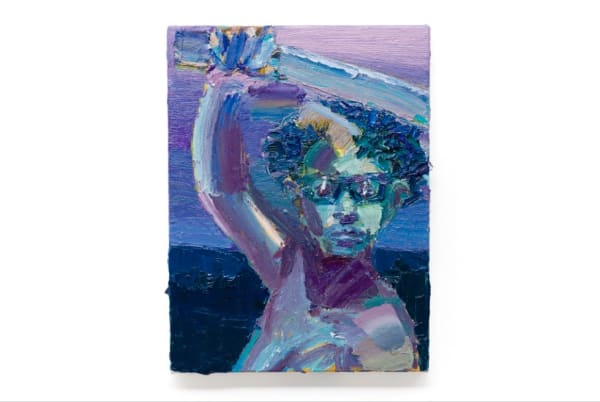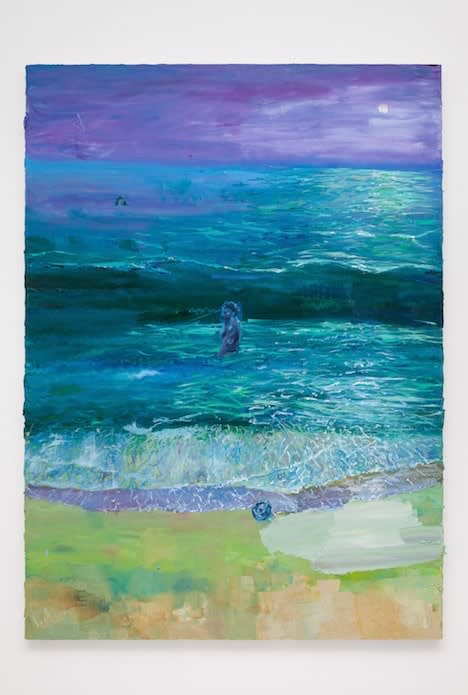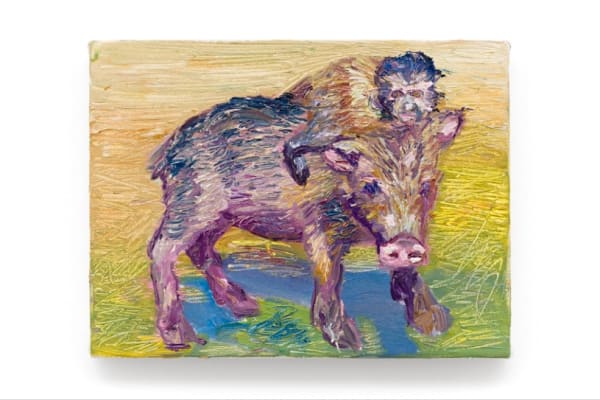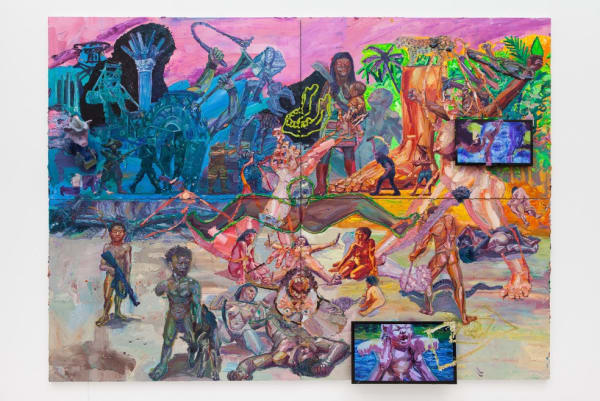bárbara balaclava Thiago Martins de Melo
When observing Thiago Martins de Melo's body of work over time, one notices a decantation of various aspects, which now culminates in the series “bárbara balaclava.”
Martins de Melo's paintings were never actually just two-dimensional. Much like a reading of his work could not be described as strictly retinal. Gradually more material, Martins de Melo has delved deeper into physicality and its ability to reveal meaning in formal pictorial structures and the materiality of their layers, drawing from an array of pictorial techniques of texture to transcend, like one who seeks to breathe life into painting.
“bárbara balaclava” is the sublime result of these formal breaks with the two-dimensional, a demonstration of painting expanded to the three-dimensional, to the image in motion and sound. In the series, Martins de Melo reinforces what the curator and critic Gunnar Kvaran previously identified as his capacity to “reinvent the narrative structure in the world of painting”1 and, which, beyond this, to reassign meaning, also in content, to the very use and conceptual reach of the traditional terms “anthropophagy” and “cannibalism.”
The works address non-legitimated struggles of peoples and groups viewed as “barbarian,” uncivilized non-citizens. Balaclava is the invisibility, discomfort or aggression caused by the battle mask, which destroys identity, personification and individuation, stores the anonymity of oppressors and the oppressed and, as such, possesses a double meaning. The shirt that covers the face, the iron mask of Anastácia, the mask of the riot squad, of the police... and many other masks worn socially by those who fear institutions as well as those who represent them.
Desire, libido and forms of sexual expression make strong returns in the works, which contain an anthropophagic, ritualistic and transmutative power. Yin yang, animus and anima, androgyny...poetics of the conjunction whose horizon is liberty.
The axis of this exhibition is the film “bárbara balaclava,” which crosses with other works, synthesizing and reinforcing their signs and meanings. The exception is a work which Thiago dedicates to Tiresias2, Exu Duas Cabeças and Saint Sebastian, addressing questions of gender identity like transsexuality.
In “bárbara balaclava,” Thiago explores time in a horizontal, almost quantum manner. The logic of this time is more connected to a “law of cause and effect” than any chronology of events. In the film's script, for example, the heroine appears living three lives in a simultaneous way: A supposed past life, as a man, a black slave thrown into the ocean from a slave ship; as a woman, recently killed by the effects of the illegal occupation and the misappropriation of land and as an enchanted entity, who fuses former existences in an androgynous immaterial body, coexisting in the present and carrying with it the scars, stories and powers of these past existences.
In the film, there is also a micro-narrative for the heroine realized by intermediary through Marselha's tarot cards, addressing aspects of the archetypical journey which she endures, like a premonition of the psychological depth of her experiences.
In one of his paintings, Thiago narrates the reincarnation of a São Paulo bandeirante3 in the womb of an indigenous woman from the Amazon, in a negation of the energetic death of history and of an end to personal spiritual journeys. The law of return does not break with the past, but it has the power to place it in the present.
As predicted by the principles of magic, the events of the narratives and their signs echo in several dimensions, times and spaces, producing energetic effects, manifesting synchronicities and propagations that are not always in sequence.
Thiago Martins e Melo (São Luís, 1981) lives and works between São Luís and Campinas. The artist has participated in numerous group exhibitions, including "The World is Made of Stories", Astrup Fearnley Museet, Oslo (2015/2016); "Imagine Brazil, DHC/Art Foundation For Contemporary Art, Montréal (2015/2016); "10th Mercosul Biennial - Messages From a New America, Porto Alegre (2015)"; "1st Bienal Internacional de Asunción - Grito de Libertad", Asunción (2015); "The Boiling Point, PSM-Gallery, Berlin (2015)"; "5th Prêmio CNI SESI SENAI Marcantonio Vilaça, Museu de Arte Contemporânea da Universidade de São Paulo, São Paulo, Brazil (2015); "31 Bienal de São Paulo", São Paulo (2014); "Imagine Brazil", Astrup Fearnley Museet, Oslo (2013) e Lyon (2014); "Entre temps... Brusquement, et ensuite", 12 La Biennale de Lyon, Lyon (2013); "Convite à Viagem", Rumos Artes Visuais, Itaú Cultural, São Paulo (2012); "Zona Tórrida: certa pintura do nordeste", Santander Cultural de Recife, Recife (2012); "Caos e Efeito", Itau Cultural, São Paulo (2011); "Os Primeiros 10 Anos", Instituto Tomie Ohtake, São Paulo (2011). His recent solo shows include: "Bárbara Balaclava", Mendes Wood DM, São Paulo (2016);"Teatro Nagô-acartesiano e o Corte Azimutal do Mundo", Mendes Wood DM, São Paulo (2013). His works is part of the permanent collections including: Thyssen-Bornemisza Art Contemporary, Viena; Astrup Fearnley Museum of Modern Art, Oslo; Rubell Family Collection, Miami; Museu de Arte Moderna do Rio de Janeiro - Coleção Gilberto Chateaubriand; Museu de Arte do Rio, Rio de Janeiro; Museu de Arte Contemporânea do Ceará, Fortaleza, and at Museu do Estado do Pará, Belém.
– Viviane Vazzi Pedro











